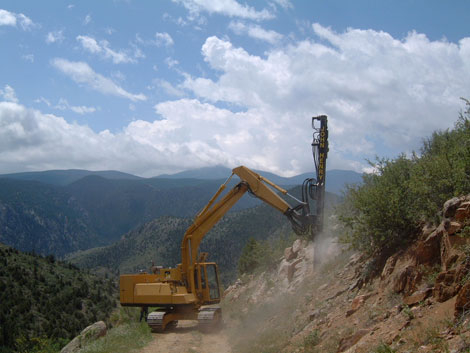
SAFE, EFFICIENT AND PROFESSIONAL ROCK DRILLING AND BLASTING FOR ALL SIZED PROJECTS
Technical Information & FAQs
Blasting. Controlled use of explosives to fragment rock, concrete or similar material into sizes that can be moved by heavy equipment.
Drills. Drills range in size from hand drills (also called sinker drills) that weigh 55 pounds and are operated by one person, to hydraulic drills on tracs that weigh up to 12 tons. Hand drills are capable of boring holes generally ranging from 1-1/2 to 2 inches in diameter. Hydraulic trac-drills bore holes ranging from 2-1/2 to 4-1/2 inches in diameter.
Blasting mats. Blasting mats are used to cover a blast, particularly in close proximity to a structure. Blast mats can be constructed of automotive treads and sidewalls, cables or manila rope. Our mats are 8’ x 10’ and weigh 35 pounds per square foot for a total weight of approximately 2,800 pounds each.
Blast cover. When blasting mats are not feasible to use, dirt is used to cover the blast site to minimize the risk of flyrock. An excavator will gently place dirt over the blasting leads, after the holes are loaded. Not every blast has to be covered. Typically no blast cover is needed when the natural overburden (soil) has not been removed. Please consult with us prior to removing overburden if blasting may be needed on your construction site.
Flyrock. Pieces of rock that become airborne at high velocity during a blast.
Frequently Asked Questions
If you are a home- or business-owner near the site of a blasting operation or if blasting will be done on your property, it is natural to have concerns and questions about the blast. We hope that the information below will address your concerns.
What types of licenses are required to conduct blasting? Both federal and state explosives licenses are required to blast. In addition, a commercial driver’s license with a hazardous materials endorsement is required.
Does the ground move during a blast? Yes. Today’s field of explosives engineering uses state-of-the-art equipment and techniques to ensure precise, safe blasting with an absolute minimum of disruption to surrounding properties.
What is an air-blast?
Air movement caused by a blast, similar to a thunderclap. Air-blasts can rattle dishes and doors and disturb pictures.
Is the ground and air movement caused by a blast measured? Yes. Seismic monitoring equipment, called a seismograph, will be placed near structures during a blast and record the amount of vibration. Seismographs are sophisticated and sensitive instruments that measure both ground vibration and air movement (air-blasts). After each blast we examine the seismograph readings to ensure blast-induced vibration and air-blast are within regulatory limits. These readings are kept on file. Only seismograph manufacturers can adjust the recording sensitivity of the unit.
How much vibration will be felt in a house or business that is near the blast site? Normal household or office activity like heavy footsteps or a slamming door will generally producer high vibration readings on a seismograph than a nearby blasting operation. You may feel vibration from the blast and hear some noise. Occasionally the blast may rattle doors and windows, pictures, or dishes.
What is a pre-blast survey? A survey that may be conducted by a construction professional prior to drilling and blasting. The pre-blast survey report documents existing defects in a structure such as cracks in a foundation or retaining wall.
How do you blast close to a structure without damaging the structure? We use a combination of techniques to minimize ground vibration and air-blasts and direct vibration away from the structure. These techniques include the spacing and depth of the holes, the amount of explosives material placed in each hole, and the timing sequence used to delay the detonators. These techniques are combined with covering the blast site with blasting mats and/or soil.
How are explosives stored? Explosives are required by state and federal laws to be stored in magazines that are constructed according to specific requirements. These requirements include a heavy wooden interior, a thick metal exterior and tamper resistant locking mechanisms. On the job site, the explosives storage magazine may be built into the bed of a truck or a portable, freestanding magazine.
Can you use explosives in holes that fill with water? Yes. Special explosives material is used that will successfully function when wet.
What happens if a thunder and lightning storm occurs while a blast site is being prepared for the blast? This is unfortunately not an unusual occurrence in the Rocky Mountain west during the summer months. A lightning strike that occurs while holes are being loaded is a potentially dangerous combination of events. We work quickly to finish loading the holes and initiate the blast when a thunderstorm appears eminent.